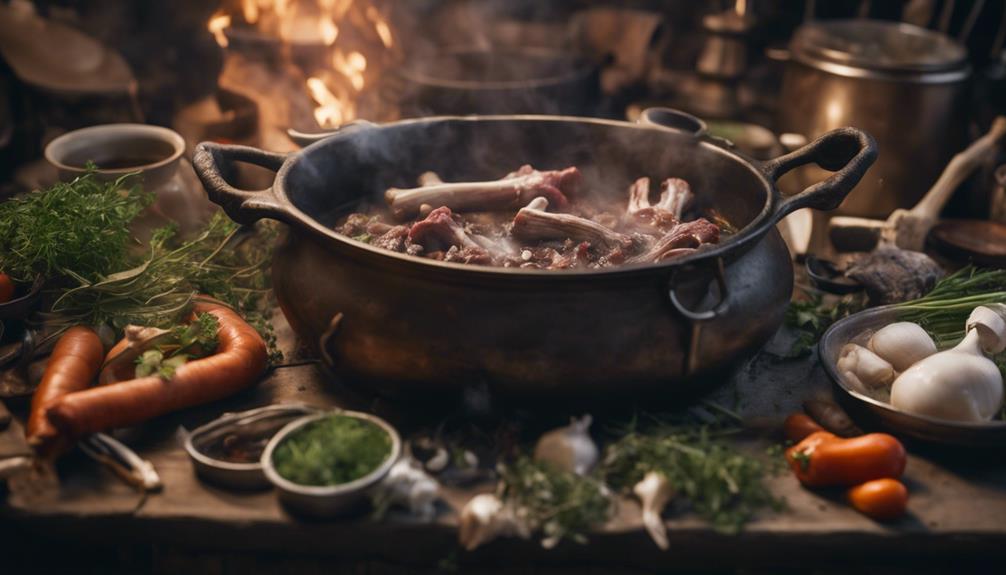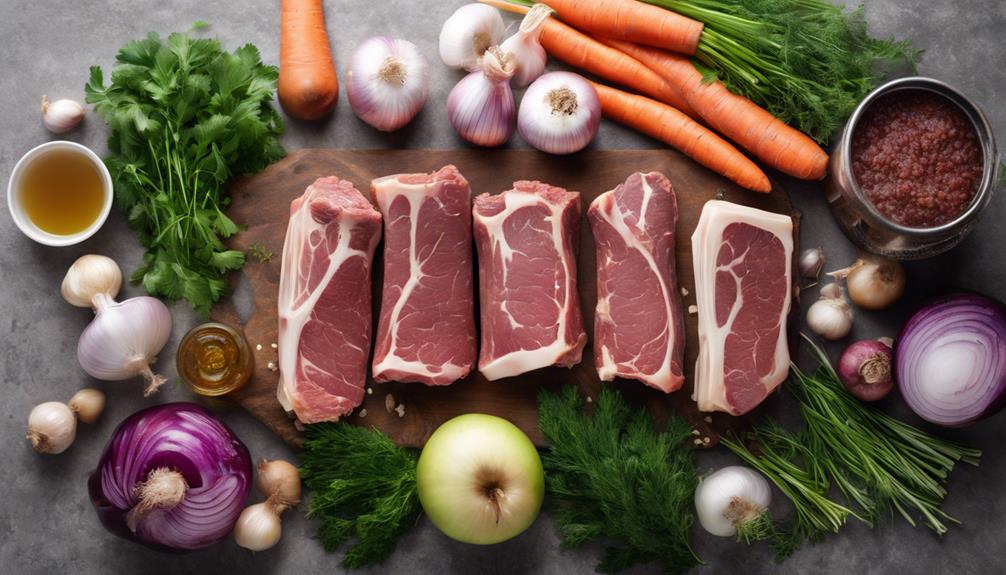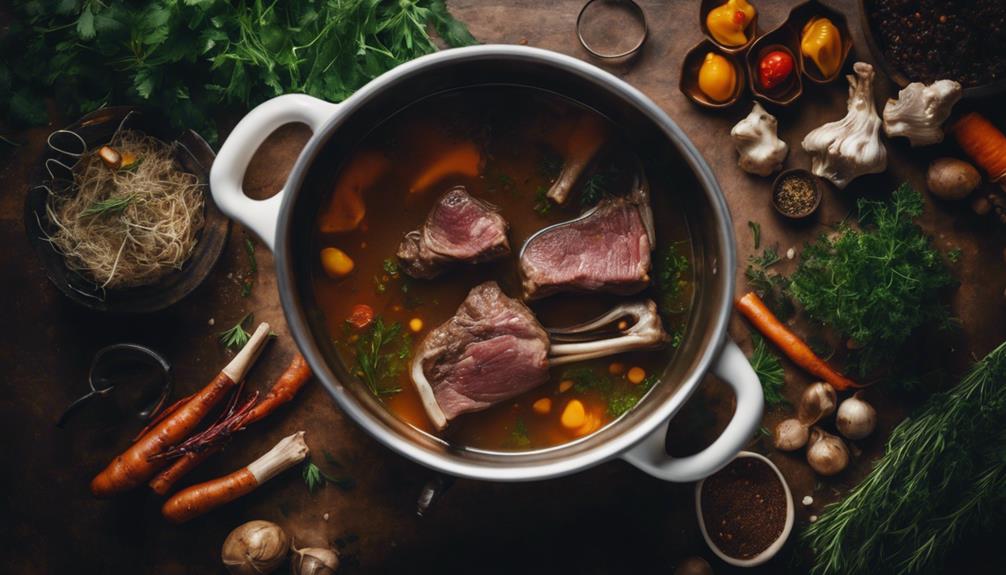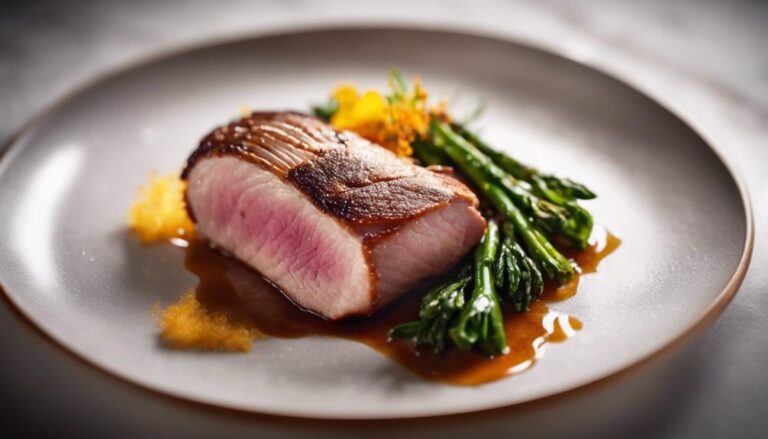Sous Vide Beef Bone Broth: A Carnivore Essential
When optimizing your carnivorous diet, consider sous vide beef bone broth, an essential ally with precise temperature control. This method enhances collagen and mineral extraction, aiding in digestion, inflammation reduction, and immunity boosting. The rich history of broth making, from ancient civilizations to modern culinary trends, underscores its significance. Variations like hearty beef and mushroom broths offer diverse flavor experiences. Simmer times impact flavor profiles, with longer durations yielding collagen-rich, nutrient-packed results. Customizable flavor infusion and various heat sources elevate broth-making possibilities. Embrace this carnivore essential for a flavorful and nutritious culinary journey.
What You Will Learn Here
- Sous vide beef bone broth maximizes collagen extraction for joint health.
- Rich in bioavailable minerals like calcium, magnesium, and phosphorus.
- Enhances gut health with essential amino acids and vitamins.
- Versatile base for soups, stews, and sauces, elevating flavor.
- Supports a carnivore diet with nutrient-dense, flavorful benefits.
Broth's Ancient Origins

Bone broth's ancient origins can be traced back to civilizations like the Egyptians, Greeks, and Romans, where it held a significant place in their diets. Valued for its nutrient density, bone broth provided essential minerals, collagen, and gelatin, believed to support overall health.
Understanding the historical context of bone broth sets the stage for appreciating its modern culinary applications and potential health benefits.
Historical Broth Origins
In ancient times, the practice of boiling bones to create a nutritious and flavorful liquid, known as broth, traces back to the early Paleolithic era.
Historical records reveal that broth was a dietary staple in ancient cultures like the Egyptians, Greeks, and Romans, esteemed for its nourishing properties.
Traditional bone broth played a crucial role in ancient Chinese medicine, utilized for its healing benefits.
Across different cultures, the preparation of broth varied, with each region incorporating unique herbs and spices to enhance its taste.
Over centuries, the art of making bone broth has evolved, with modern techniques such as sous vide refining the extraction of nutrients and flavors, while still honoring the traditional methods of creating this ancient elixir.
Nutritional Benefits Overview
Throughout history, the consumption of broth has been integral to various cultures worldwide, recognized for its healing properties and nutritional significance.
When it comes to sous vide beef bone broth, the slow and controlled cooking process guarantees that essential nutrients like collagen, gelatin, and amino acids are preserved, offering benefits for gut health, joint function, and skin elasticity.
This method also aids in extracting bioavailable minerals such as calcium, magnesium, and phosphorus, making it a valuable addition to the carnivore diet.
By utilizing sous vide for beef bone broth, you can create a nutrient-dense and flavorful elixir that supports digestion, reduces inflammation, and boosts overall immune function.
The combination of precise temperature control and extended cooking times enhances the broth's nutritional profile, delivering a potent source of nourishment.
Modern Culinary Applications
With its ancient roots dating back to prehistoric times, beef bone broth has evolved into a versatile culinary ingredient used in modern cooking practices. Modern culinary applications of beef bone broth revolve around its rich flavor profile and numerous health benefits. Below is a table showcasing some popular uses of beef bone broth in today's culinary landscape:
| Culinary Application | Description | Best Cooking Times | Ideal Temperatures | Recommended Dishes |
|---|---|---|---|---|
| Soup Base | Provides a robust foundation for soups | 12-24 hours | 185°F (85°C) | Beef stew, vegetable soup |
| Sauce Enhancer | Adds depth and richness to sauces | 8-12 hours | 180°F (82°C) | Gravy, braising liquids |
| Sipping Elixir | Enjoyed on its own for a nutritious drink | 6-8 hours | 175°F (79°C) | Daily bone broth consumption |
Key Broth Components

Extracting the key components from beef bones is essential in developing a robust and flavorful broth in sous vide cooking. When preparing beef bone broth, the connective tissues in the bones play a significant role in imparting rich flavors and beneficial nutrients.
Here are the key components to focus on:
- Collagen: Found abundantly in connective tissues, collagen breaks down during cooking to form gelatin, providing a velvety texture and mouthfeel to the broth.
- Essential Amino Acids: The slow extraction process in sous vide guarantees that amino acids like proline and glycine are released, contributing to the broth's nutritional profile.
- Minerals: Beef bone broth is a natural source of essential minerals such as calcium and magnesium, crucial for bone health and overall well-being.
- Gelatin: Derived from collagen, gelatin adds body and depth to the broth, enhancing its flavor and making it a versatile base for various dishes.
Tasty Broth Variations
When exploring tasty variations for your beef bone broth, consider the rich flavors of Hearty Beef and Veggie Broth, the earthy notes of Savory Mushroom Broth, and the wholesome combination of Beef Shank and Barley Broth.
These variations can offer diverse taste experiences by incorporating different ingredients and cooking techniques, allowing you to customize your broth to suit your preferences.
Experimenting with these flavorful options can broaden your culinary repertoire and enhance the enjoyment of your sous vide beef bone broth.
Hearty Beef and Veggie Broth
To enhance the robustness of your beef bone broth, infuse it with the hearty flavors of assorted vegetables for a more complex and nutrient-packed variation. When creating a hearty beef and veggie broth, consider adding ingredients like:
- Carrots: Provide a touch of sweetness and earthiness.
- Celery: Imparts a subtle herbal note and depth of flavor.
- Onions: Add layers of savory complexity to the broth.
- Garlic: Enhances the overall aroma and taste profile of the broth.
Savory Mushroom Broth
For a flavorful twist on traditional beef bone broth, consider incorporating the rich umami taste of savory mushrooms to create a robust and satisfying mushroom broth variation. When preparing this savory mushroom broth, the earthy notes from the mushrooms beautifully complement the beefy essence, enhancing the overall depth of flavor.
To achieve the best results, be sure to include dried shiitake mushrooms for an extra layer of richness. This mushroom broth variation not only offers a unique alternative for vegetarians but also provides a hearty and robust taste that's perfect for mushroom enthusiasts.
Immerse yourself in this delicious fusion of flavors and elevate your broth game with this mushroom-infused creation.
Beef Shank and Barley Broth
Incorporating beef shank and barley into your broth offers a robust and nourishing twist that elevates the depth and complexity of flavors. When preparing this variation for the first time, consider the following:
- Rich Flavor: Beef shank adds a meaty richness that enhances the overall depth of the broth.
- Hearty Texture: Barley provides a hearty texture and nutty taste, complementing the beefy essence of the broth.
- Tender Meat: Slow cooking the beef shank in sous vide results in tender, succulent meat that easily falls off the bone.
- Comforting Broth: The combination of beef shank and barley creates a nourishing, satisfying broth perfect for cold days.
This variation offers a comforting and wholesome option, ideal for those seeking a hearty, carnivorous broth experience.
Broth Simmering Techniques
When simmering beef bones, control the simmering time meticulously to draw out the richest flavors and nutrients.
Infuse the broth with depth by strategically adding vegetables, herbs, and spices towards the end of the simmering process.
Consider different heat source options for varying intensities and textures in your broth.
Simmering Time Control
To maximize flavor and nutrients from beef bones in sous vide beef bone broth, precise control over simmering time is essential. By adjusting the period of time beef bones simmer, you can customize the richness and depth of your broth to suit your preferences. Longer simmering times, ranging up to 48 hours at low temperatures, result in a collagen-rich, intense flavor profile. On the other hand, a shorter simmering time of about 12-24 hours produces a lighter broth with a different taste. Experimenting with various simmering times allows you to find the perfect balance of flavor, nutrients, and texture. The table below summarizes the effects of different simmering times on the sous vide beef bone broth:
| Simmering Time | Flavor Profile | Nutrient Extraction | Broth Consistency |
|---|---|---|---|
| Up to 48 hours | Rich, collagen-packed | High | Thick |
| 12-24 hours | Lighter, different | Moderate | Medium viscosity |
Flavor Infusion Methods
For ideal flavor infusion in your sous vide beef bone broth, consider experimenting with different broth simmering techniques to enhance the depth and richness of your final product.
While sous vide cooking already provides a controlled environment for flavor development, you can further elevate your broth by adding ingredients like herbs, spices, or vegetables directly into the sous vide bag with the beef bones. This method allows for easy removal of these flavor-enhancing elements once the cooking process is complete.
Additionally, using a cheesecloth sachet to contain these added ingredients can make them even easier to remove. By incorporating these simple techniques, you can customize the flavor profile of your beef bone broth while ensuring that unwanted remnants are easy to remove, resulting in a clean and pure final product.
Heat Source Options
Consider employing different heat source options for simmering your beef bones when preparing sous vide beef bone broth to achieve peak flavor extraction and consistency in your final product. To guarantee top-notch results, choose the right heat source right away. Below is a comparison table outlining various heat source options for simmering beef bones:
| Heat Source | Description | Advantages | Disadvantages |
|---|---|---|---|
| Sous Vide | Precise temperature control at 185°F | Maximum flavor extraction | Requires equipment |
| Stovetop | Traditional method with inconsistent heat | Easy accessibility | Risk of scorching |
| Immersion Circulator | Even cooking for rich, gelatinous broth | Ensures uniformity | Equipment needed |
| Slow Cooker | May not reach optimal collagen breakdown temps | Convenient and hands-off cooking | Slower collagen breakdown |
Final Thoughts
In concluding our exploration of sous vide beef bone broth, it's evident that this nutrient-dense elixir holds immense potential for enhancing the nutritional profile of a carnivore diet. The slow cooking process of sous vide allows for excellent extraction of collagen and minerals from beef bones, providing essential amino acids, vitamins, and minerals important for overall health. By incorporating sous vide beef bone broth into your diet, you can support gut health and improve joint function due to its rich nutrient content.
Moreover, the versatility of sous vide beef bone broth offers opportunities for creative culinary exploration. Whether used as a base for soups, stews, or simply enjoyed on its own, this broth ensures you receive a wide array of nutrients in a delicious form. The benefits of sous vide beef bone broth go beyond mere sustenance; they contribute to a well-rounded carnivore diet that prioritizes both flavor and nutrition. So, when considering what to include in your diet, remember that sous vide beef bone broth stands out as a fundamental element that can elevate your culinary experience like nothing else.
Frequently Asked Questions
Can You Have Bone Broth on the Carnivore Diet?
Yes, you can have bone broth on the carnivore diet. It offers numerous benefits like supporting muscle growth, providing essential nutrients, aiding in hydration, promoting gut health, and preventing nutrient deficiencies. Incorporating bone broth is valuable for carnivorous eating patterns.
What Is the Best Meat for Bone Broth?
For the best meat for bone broth, chicken bones are a top choice. They offer a delicate flavor profile and ample collagen content. Incorporating chicken bones into your broth can enhance its nutritional value and create a delicious base.
What's the Difference Between Beef Broth and Bone Broth?
When comparing beef broth and bone broth, know that bone broth offers more broth benefits like collagen and gelatin for joint health and digestion. Beef broth, while rich in flavor, may lack these essential components.
Is 4 Hours Too Long to Sous Vide a Steak?
Cooking a steak sous vide for 4 hours can result in mushiness and loss of tenderness. The ideal range is 1 to 3 hours, depending on thickness. Longer times are better for tougher cuts needing collagen breakdown.
Conclusion
In summary, sous vide beef bone broth is a crucial component of the carnivore diet, providing essential nutrients and rich flavors.
By utilizing precise temperature control and extended cooking times, this method guarantees maximum extraction of collagen, minerals, and amino acids.
Experimenting with different herbs, spices, and vegetables allows for endless variations to suit individual tastes.
Incorporating this nutrient-dense broth into your diet not only supports overall health but also satisfies the palate with its depth of flavor.











